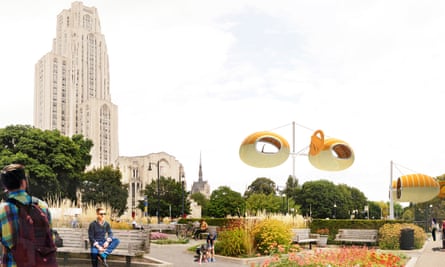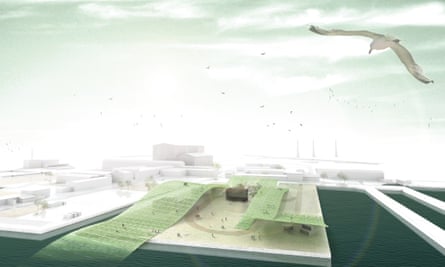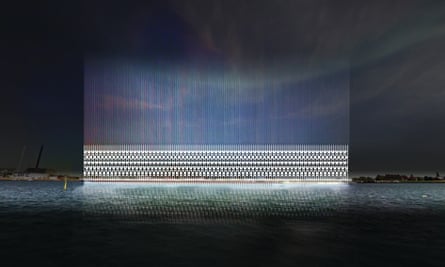What happens when renewable energy meets public art? The Land Art Generator Initiative, or Lagi, founded by Pittsburgh-based artists Elizabeth Monoian and Robert Ferry, is trying to find the answer with several proposed public art structures designed to generate power while inspiring and educating their viewers.
The initiative has collected hundreds of designs from competitions held in Abu Dhabi, New York City and Copenhagen. At the 2016 competition, which will be held in Santa Monica, California, entrants will design structures that harvest clean energy or generate clean drinking water.
“Public art can contribute to the solutions we need to steer us away from the effects of climate change,” Monoian said at October’s SXSW Eco conference in Austin, Texas.
One of the initiative’s structures, WindNest, is designed to generate wind and solar energy from four overhead pods that rotate in response to wind currents. The initiative is currently working to install the WindNest in Pittsburgh. If it succeeds, it will be the first of the competition’s designs to be constructed.
“It takes a long time for new ideas like this to make their way into the mainstream,” Ferry said. “There are great precedents for ambitious works of public art at the same scale.”
Several cities, including Glasgow, have asked Monoian and Ferry to help them install a regenerative public art structure. The two artists are matching three teams that entered Lagi’s past competitions with Glasgow, which will hold a design discussion next month.
In the meantime, Ferry said he believes Lagi is changing the way people are thinking about solutions to renewable energy and climate change.
“If we are serious about attaining 100% renewable energy infrastructure, then it will have a profound influence on the visual environment of our cities and rural landscapes,” he said.
“There is an opportunity to generate site-specific solutions that respond to the needs of the community that lives and works within these new energy landscapes.”
Here are some of Lagi’s proposed designs:
WindNest
A prototype of the WindNest project, designed for Lagi’s 2010 Abu Dhabi competition, was built last fall. If approved, it will be built in Pittsburgh, and visitors will be able to charge their cell phones using wind and solar energy generated from the overhead rotating nests. Estimated annual capacity: 8,000 kWh.

Windstalk
Inspired by the movement of wind through a wheat field, this proposed installation by New York City-based designers would have 1,200 stalks that are 55m high, arranged in a logarithmic spiral. When it rains, water would run down the stalks and collect at the bottom, feeding a garden of native plants. Wind power would sway the stalks, generating energy and making them light up. Estimated annual capacity: 20,000 MWh.

Solar Hourglass
This proposed project from a Brazilian designer could power hundreds of homes using concentrated solar power. An array of mirrors would create a beam of solar energy visible to anyone who walks under the structure. Estimated annual capacity: 7,500 MWh.

Algaescape
Designed to produce biogas from algae, the Algaescape, proposed by a group of German designers, uses a mesh-like material to provide an ideal growing environment for algae biomass. The public would be able to see the algae grow from an open pavilion. Estimated annual capacity: 436 MWh.

Light Guard
This proposed structure from French designer Vincent Trarieux has 137 metal columns, mounted with LED lights and PV panels. The lights are normally blue, but turn red when sea levels rise high enough to pose a flood risk. Estimated annual capacity: 1,250 MWh.

Light Sanctuary
Made up of 40km of translucent and flexible photovoltaic ribbons that are attached to masts, Light Sanctuary, a proposed project by New York City-based designers, will absorb light and produce electricity. The 10m-long ribbons self clean when dust and dirt particles are shaken off during movement. Estimated annual capacity: 4,500 MWh.


Comments (…)
Sign in or create your Guardian account to join the discussion